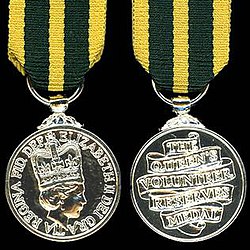| King's Volunteer Reserves Medal | |
|---|---|
 Obverse and reverse of the medal | |
| Awarded for | Exemplary personal performance over an extended period of service in the Reserve Forces. [1] |
| Country | |
| Presented by | The Monarch |
| Eligibility | Members of the • Army Reserve • Royal Auxiliary Air Force • Royal Naval Reserve • Royal Marines Reserve |
| Post-nominals | KVRM [2] |
| Clasps | None |
| Established | 29 March 1999 [3] |
| Ribbon of KVRM | |
| Order of Wear | |
| Next (higher) | King's Ambulance Service Medal [4] [5] |
| Next (lower) | Queen's Medal for Chiefs (de jure) [5] British campaign medals, United Nations Medals, and Medals of recognised International Organisations in order of award (de facto) [1] |
The King's Volunteer Reserves Medal (KVRM), originally the Queen's Volunteer Reserves Medal (QVRM), was created by Royal Warrant of Queen Elizabeth II on 29 March 1999. [3] Only 13 King's Volunteer Reserves Medals may be awarded in a year (although it appears more have been issued in some years - as of 2018, more than the 13 were awarded in 8 of the medal's 20-year history: 19 medals were awarded in 2011; 16 in 2003 and 2000; 14 in 2018, 2017, 2013, 2009 and 2002). [6] The medal is presented only to members of the Volunteer Reserves of the British Armed Services for exemplary meritorious service in the conduct of their duties. [7] The KVRM is a Level 3 award and ranks in military order of wear immediately after the British Empire Medal. [1] It is the first exclusive award to Volunteer Reserves that is presented at an investiture. The first awards were announced in the 1999 Queen's Birthday Honours with these first awards presented at an investiture on 5 November 1999. [7]